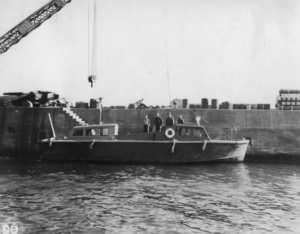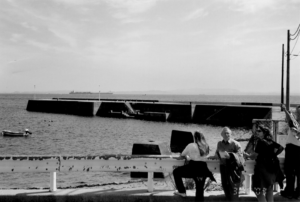
Sometime in the early winter of 1945 the sailors at HECP (not the Navy officially) came to be the de facto owners of a landing barge. These were the barges which ferried soldiers or marines from a troop transport onto a beach. There, they sailed onto the sand and dropped the platform and the thirty or so infantry stormed ashore.
We came into possession of the barge because of an early storm. Somehow it got loose from the mother ship and the strong current out of Tokyo bay carried it to our vicinity, where the tide left it on the beach of our neighboring fishing village of Kamoi. We did not see it, officially, and with some help from the Japanese did some elementary camouflage work. We painted out the number and let our Japanese neighbors know that it was our project and that they would not get into trouble.
When the mother ship sailed out of the harbor it became ours, since possession is nine tenths of the law; that’s what we said anyway. We used it for short trips in the immediate vicinity and for personal recreational use. We did not actually use it much after the novelty wore off. There were few places of interest which we could travel to at four knots an hour. Besides, getting gasoline for it was always a problem. As far as I know, this barge was just left at the dock when we closed the base.
It should be added that the base actually had two boats assigned to it. One was a mate to the one we found. The other was a speedy twin diesel engine picket boat. It was used when we were ordered to inspect ships more closely or to take boarders out to a ship. On rare occasions it was actually sailed into Yokosuka Navy Base. Once, as a part of the crew, I sailed around the battleship Missouri. What a monster, and what lines. We felt like minnows.

I was on the picket boat once in a rousing storm when we had to take written orders out to an ancient tramp steamer because they had neither a signalman nor a radioman on board. We came up on the lee side and used a portable speaker which got shorted out by a wave that drenched our ensign at the same time. I was ordered to throw a monkey’s fist with a light line attached up to the ship. I did a couple lasso-like swings, and the weight sailed up to the bridge of the ship. We then quickly attached the orders in a water tight pack, tied it on, and high-tailed it back to our tiny jetty protected harbor; but not before the heavy seas caused us to touch bottom with a small, capsized, submerged vessel of some sort which we never saw again.
The picket boat performed other important functions also. When a British Navy Destroyer came into the ship channel on its way inbound one day, our officer in charge came to the tower and sent a message to the British captain and asked if they would be interested in trading some rum for some beer. They were interested. Once again, I managed to get on the crew. We pulled up to a ship manned by East Indians, all of whom wore short pants, which we thought hilarious. Our officer went on board and visited for a bit. We got our rum and they got their beer. The rum was rationed out. I thought it was better than whiskey.


Pingback: Remembering Japan: 1945 – 1946: Chapter Seven: The Toriga Saki Fleet | I Make Up Worlds
Pingback: Remembering Japan: 1945 – 1946: Chapter Eight: The Cold War Begins? | I Make Up Worlds
Pingback: Remembering Japan: 1945-1946: Chapter Nine: A Social Call | I Make Up Worlds